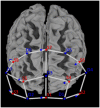Phasic and repetitive self-touch differ in hemodynamic response in the prefrontal cortex-An fNIRS study
- PMID: 38234502
- PMCID: PMC10790951
- DOI: 10.3389/fnrgo.2023.1266439
Phasic and repetitive self-touch differ in hemodynamic response in the prefrontal cortex-An fNIRS study
Abstract
Introduction: Each individual touches the own body several 100 times a day. While some researchers propose a self-regulatory function of self-touch, others report that self-touching increases nervousness. This controversy appears to be caused by the fact that researchers did not define the kind of self-touch they examined and actually, referred to different types of self-touch. Thus, kinematically defining different types of self-touch, such as phasic (discrete), repetitive, and irregular, and exploring the neural correlates of the different types will provide insight into the neuropsychological function of self-touching behavior.
Methods: To this aim, we assessed hemodynamic responses in prefrontal brain areas using functional near-infrared spectroscopy (fNIRS) and behavioral responses with NEUROGES®. Fifty-two participants were recorded during three specific kinematically types of self-touch (phasic, irregular, repetitive) that were to be performed on command. The recently developed toolbox Satori was used for the visualization of neuronal processes.
Results: Behaviorally, the participants did not perform irregular self-touch reliably. Neurally, the comparison of phasic, irregular and repetitive self-touch revealed different activation patterns. Repetitive self-touch is associated with stronger hemodynamic responses in the left Orbitofrontal Cortex and the Dorsolateral Prefrontal Cortex than phasic self-touch.
Discussion: These brain areas have been reported to be associated with self-regulatory processes. Furthermore, irregular self-touch appears to be primarily generated by implicit neural control. Thus, by distinguishing kinematically different types of self-touch, our findings shed light on the controverse discussion on the neuropsychological function of self-touch.
Keywords: functional near-infrared spectroscopy; left dorsolateral prefrontal cortex; left orbitofrontal cortex; prefrontal activity; self-touch.
Copyright © 2023 von Au, Helmich, Kieffer and Lausberg.
Conflict of interest statement
The authors declare that the research was conducted in the absence of any commercial or financial relationships that could be construed as a potential conflict of interest.
Figures




Similar articles
-
Social-touch and self-touch differ in hemodynamic response in the prefrontal cortex - a fNIRS study conducted during the coronavirus pandemic.Soc Neurosci. 2024 Aug;19(4):231-245. doi: 10.1080/17470919.2024.2404621. Epub 2024 Sep 21. Soc Neurosci. 2024. PMID: 39305237
-
An Exploratory Analysis of the Neural Correlates of Human-Robot Interactions With Functional Near Infrared Spectroscopy.Front Hum Neurosci. 2022 Jul 18;16:883905. doi: 10.3389/fnhum.2022.883905. eCollection 2022. Front Hum Neurosci. 2022. PMID: 35923750 Free PMC article.
-
Reduced dorsolateral prefrontal cortical hemodynamic response in adult obsessive-compulsive disorder as measured by near-infrared spectroscopy during the verbal fluency task.Neuropsychiatr Dis Treat. 2013;9:955-62. doi: 10.2147/NDT.S45402. Epub 2013 Jul 11. Neuropsychiatr Dis Treat. 2013. PMID: 23874098 Free PMC article.
-
Neuroimaging and neuromodulation approaches to study eating behavior and prevent and treat eating disorders and obesity.Neuroimage Clin. 2015 Mar 24;8:1-31. doi: 10.1016/j.nicl.2015.03.016. eCollection 2015. Neuroimage Clin. 2015. PMID: 26110109 Free PMC article. Review.
-
Light up ADHD: I. Cortical hemodynamic responses measured by functional Near Infrared Spectroscopy (fNIRS): Special Section on "Translational and Neuroscience Studies in Affective Disorders" Section Editor, Maria Nobile MD, PhD. This Section of JAD focuses on the relevance of translational and neuroscience studies in providing a better understanding of the neural basis of affective disorders. The main aim is to briefly summarise relevant research findings in clinical neuroscience with particular regards to specific innovative topics in mood and anxiety disorders.J Affect Disord. 2018 Jul;234:358-364. doi: 10.1016/j.jad.2017.11.087. Epub 2017 Nov 21. J Affect Disord. 2018. PMID: 29195758 Review.
References
-
- Allaire J. (2012). RStudio: Integrated Development Environment for R. Boston, MA. 770, 165–171.
-
- Boehme R., Olausson H. (2022). Differentiating self-touch from social touch. Curr. Opin. Behav. 43, 27–33. 10.1016/j.cobeha.2021.06.012 - DOI
LinkOut - more resources
Full Text Sources

